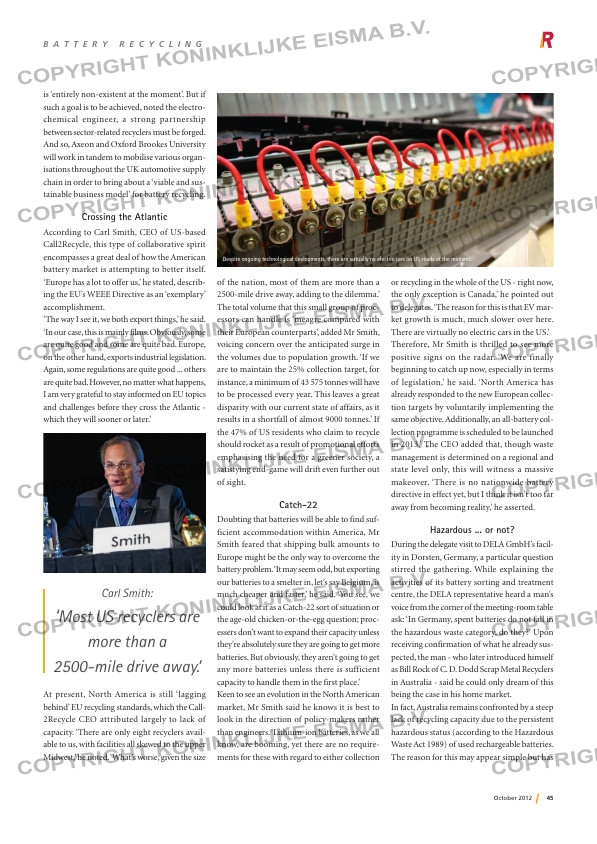Page 45 from: October 2012

45October 2012
is ‘entirely non-existent at the moment’. But if
such a goal is to be achieved, noted the electro-
chemical engineer, a strong partnership
between sector-related recyclers must be forged.
And so, Axeon and Oxford Brookes University
will work in tandem to mobilise various organ-
isations throughout the UK automotive supply
chain in order to bring about a ‘viable and sus-
tainable business model’ for battery recycling.
Crossing the Atlantic
According to Carl Smith, CEO of US-based
Call2Recycle, this type of collaborative spirit
encompasses a great deal of how the American
battery market is attempting to better itself.
‘Europe has a lot to offer us,’ he stated, describ-
ing the EU’s WEEE Directive as an ‘exemplary’
accomplishment.
‘The way I see it, we both export things,’ he said.
‘In our case, this is mainly films. Obviously, some
are quite good and some are quite bad. Europe,
on the other hand, exports industrial legislation.
Again, some regulations are quite good … others
are quite bad. However, no matter what happens,
I am very grateful to stay informed on EU topics
and challenges before they cross the Atlantic –
which they will sooner or later.’
At present, North America is still ‘lagging
behind’ EU recycling standards, which the Call-
2Recycle CEO attributed largely to lack of
capacity. ‘There are only eight recyclers avail-
able to us, with facilities all skewed to the upper
Midwest,’ he noted. ‘What’s worse, given the size
of the nation, most of them are more than a
2500-mile drive away, adding to the dilemma.’
The total volume that this small group of proc-
essors can handle is ‘meagre compared with
their European counterparts’, added Mr Smith,
voicing concern over the anticipated surge in
the volumes due to population growth. ‘If we
are to maintain the 25% collection target, for
instance, a minimum of 43 575 tonnes will have
to be processed every year. This leaves a great
disparity with our current state of affairs, as it
results in a shortfall of almost 9000 tonnes.’ If
the 47% of US residents who claim to recycle
should rocket as a result of promotional efforts
emphasising the need for a greener society, a
satisfying end-game will drift even further out
of sight.
Catch-22
Doubting that batteries will be able to find suf-
ficient accommodation within America, Mr
Smith feared that shipping bulk amounts to
Europe might be the only way to overcome the
battery problem. ‘It may seem odd, but exporting
our batteries to a smelter in, let’s say Belgium, is
much cheaper and faster,’ he said. ‘You see, we
could look at it as a Catch-22 sort of situation or
the age-old chicken-or-the-egg question; proc-
essers don’t want to expand their capacity unless
they’re absolutely sure they are going to get more
batteries. But obviously, they aren’t going to get
any more batteries unless there is sufficient
capacity to handle them in the first place.’
Keen to see an evolution in the North American
market, Mr Smith said he knows it is best to
look in the direction of policy-makers rather
than engineers. ‘Lithium-ion batteries, as we all
know, are booming, yet there are no require-
ments for these with regard to either collection
or recycling in the whole of the US – right now,
the only exception is Canada,’ he pointed out
to delegates. ‘The reason for this is that EV mar-
ket growth is much, much slower over here.
There are virtually no electric cars in the US.’
Therefore, Mr Smith is thrilled to see more
positive signs on the radar. ‘We are finally
beginning to catch up now, especially in terms
of legislation,’ he said. ‘North America has
already responded to the new European collec-
tion targets by voluntarily implementing the
same objective. Additionally, an all-battery col-
lection programme is scheduled to be launched
in 2013.’ The CEO added that, though waste
management is determined on a regional and
state level only, this will witness a massive
makeover. ‘There is no nationwide battery
directive in effect yet, but I think it isn’t too far
away from becoming reality,’ he asserted.
Hazardous … or not?
During the delegate visit to DELA GmbH’s facil-
ity in Dorsten, Germany, a particular question
stirred the gathering. While explaining the
activities of its battery sorting and treatment
centre, the DELA representative heard a man’s
voice from the corner of the meeting-room table
ask: ‘In Germany, spent batteries do not fall in
the hazardous waste category, do they?’ Upon
receiving confirmation of what he already sus-
pected, the man – who later introduced himself
as Bill Rock of C. D. Dodd Scrap Metal Recyclers
in Australia – said he could only dream of this
being the case in his home market.
In fact, Australia remains confronted by a steep
lack of recycling capacity due to the persistent
hazardous status (according to the Hazardous
Waste Act 1989) of used rechargeable batteries.
The reason for this may appear simple but has
Carl Smith:
‘Most US recyclers are
more than a
2500-mile drive away.’
B A T T E R Y R E C Y C L I N G
Despite ongoing technological devlopments, there are virtually no electric cars on US roads at the moment.
R _8- in .indd 08-10-12 1 :21



